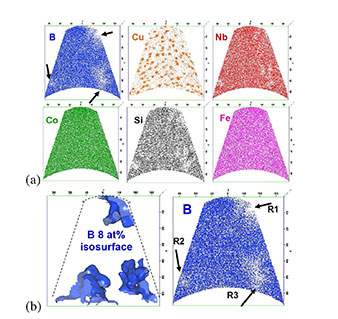| Posted: Dec 10, 2015 |
Characterization of soft magnetic nanocomposites
(Nanowerk News) This work ("Mass Balance and Atom Probe Tomography Characterization of Soft Magnetic (Fe65Co35)79.5B13Si2Nb4Cu1.5 Nanocomposites") is one effort in the Materials Synthesis and Simulation Across Scales (MS3) initiative to develop scalable synthesis methods through increased understanding of underpinning scientific principles.
|
|
Optimizing the performance of soft magnetic materials requires an understanding of the nanostructure and consideration of the local composition of each phase. The researchers successfully correlated the crystallization state in the alloy to local composition with novel mass balance. The alloy of composition (Fe65Co35)79.5B13Si2Nb4Cu1.5 was synthesized and subsequently heat-treated by the research group of Professor Michael McHenry of Carnegie Mellon University.
|
|
Atom probe tomography (APT) was then used to characterize the various stages of crystallization in EMSL, the Environmental Molecular Sciences Laboratory. APT produced 3-D atom maps of all alloy constituents (shown in the IEEE Transactions on Magnetics cover).
|
 |
| The figure depicting the atom maps obtained from atom probe tomography was featured on the cover for the IEEE Transactions on Magnetics June 2015 issue.
|
|
The local concentrations of elements obtained through APT were then used in mass balances (quantifying the glass formers in nanocrystals, enrichment of glass formers, and depletion of iron and cobalt in the amorphous phase).
|
|
Why is this important?
|
|
Soft magnetic materials do not retain their magnetism when removed from a magnetic field and are widely used to construct magnetic components for motors, power generators, and power electronics. “Soft” refers to their small coercivity, meaning they can be easily magnetized or demagnetized. The challenge is to develop scalable routes for producing bulk quantities of soft magnetic material while retaining the unique nanoscale features responsible for the desirable soft magnetic properties.
|
|
Improving the performance of bulk soft magnetic materials can make a large impact in power conversion and electric machines alone because 30 percent of electricity consumed in the United States is used by electric motors, and 80 percent of all generated electricity is projected to flow through power electronics by 2030. High-performance soft magnetic materials can greatly improve the efficiency of electricity generation. For example, a 1 percent increase in energy generation efficiency through advanced soft magnetic materials can result in 159 TWh in energy savings.
|
|
Relation to MS3
|
|
A goal of the MS3 Initiative is to develop methods to produce bulk nanostructured materials using scalable, cost-effective processes based on an understanding of the scientific principles underlying those processes. PNNL is using novel processing techniques to produce bulk nanostructured materials with nanometer-sized features for use in power electronics (soft magnets), waste energy harvesting (thermoelectric), and lightweight cars/trucks (structural materials). These techniques could revolutionize our ability to make advanced, high-performance materials.
|

